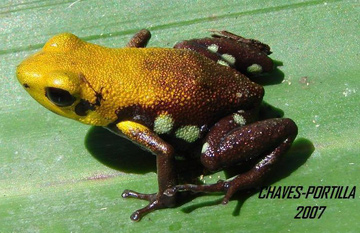New poison frog species discovered in Colombia
New poison frog species discovered in Colombia
mongabay.com
August 28, 2007
Scientists have discovered a previously unknown species of poison frog in a remote mountainous region in Colombia. The tiny frog has been dubbed the “golden frog of Supatá” and lives only in a 20 hectare area in Colombia’s Cundinamarca region.
The scientists who made the discovery say very little is known about the species other than it belongs to a group of highly venomous “dart fogs.”
“The importance of this project is not just the discovery of the new frog,” said Oswaldo Cortes, team leader and one of the winners of the 2007 Conservation Leadership Programme awards. “But, most importantly, what this new discovery shows is how little we still know about our planet, and the many species that haven’t yet been discovered. This is why it is so important to work with local communities and educate them about the need for conservation.”

The golden frog of Supatá. Photo by Giovanni Chaves. |
Colombia has more than 620 species of amphibians according to the World Conservation Monitoring Center of the United Nations Environment Program. Only Brazil is known to have more species.
Poison dart frogs, colorful amphibians with skin secretions so toxic that they are used by indigenous populations to poison the tips of hunting arrows, are one of several groups of animals capable of sequestering deadly compounds from dietary sources without being harmed.
Related
“Extinct” frog rediscovered in Colombia
Researchers exploring a Colombian mountain range found surviving members of a species of Harlequin frog believed extinct due to a killer fungus wiping out amphibian populations in Central and South America.
Why poison dart frogs are poisonous
Mites — not ants as long believed — appear to be the primary source of toxins used by poison arrow frogs to defend against predators, reports new research published in the early online edition of Proceedings of the National Academy of Sciences (PNAS).